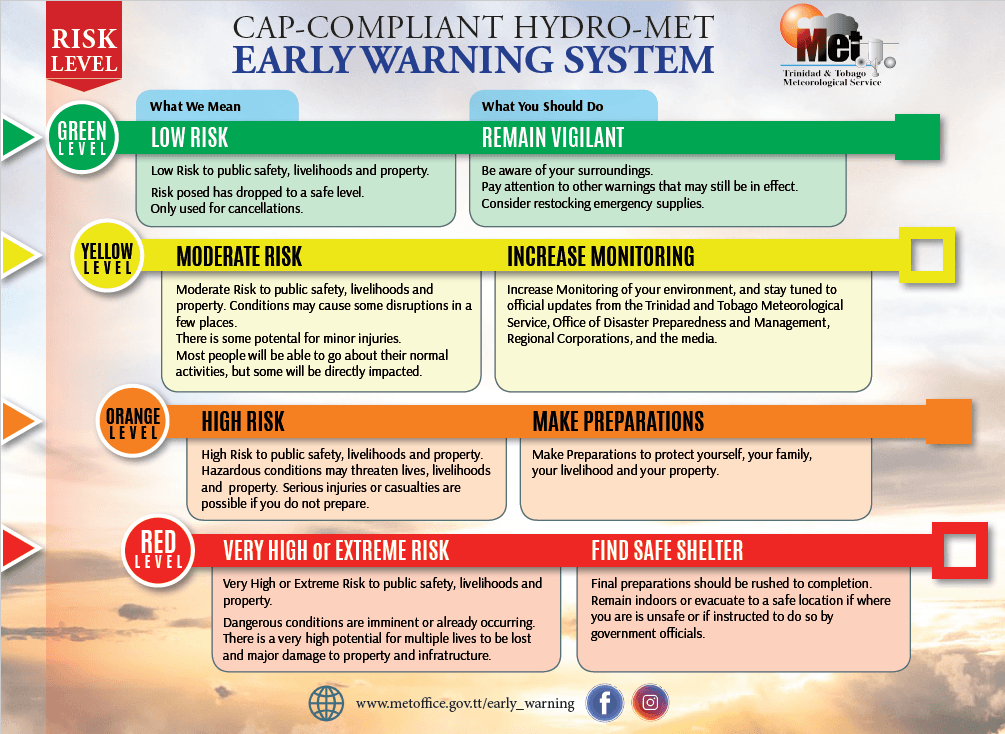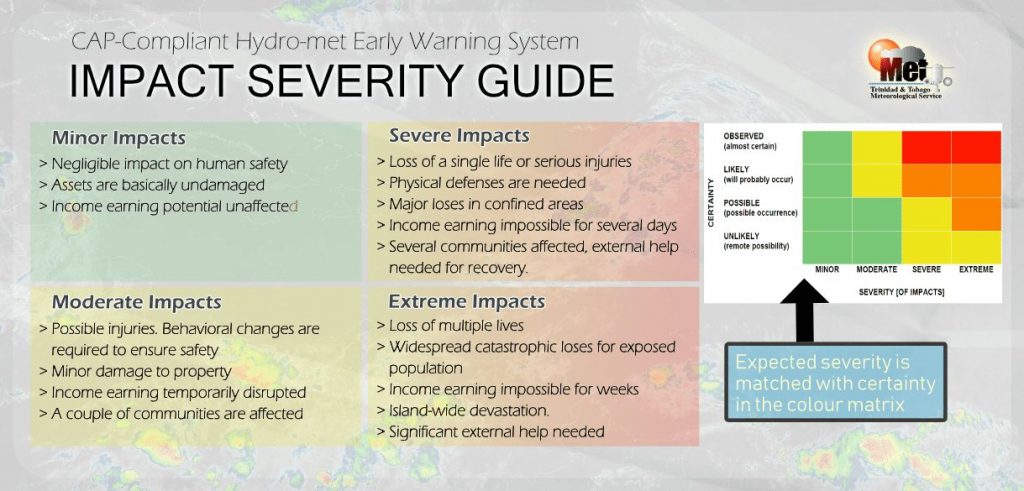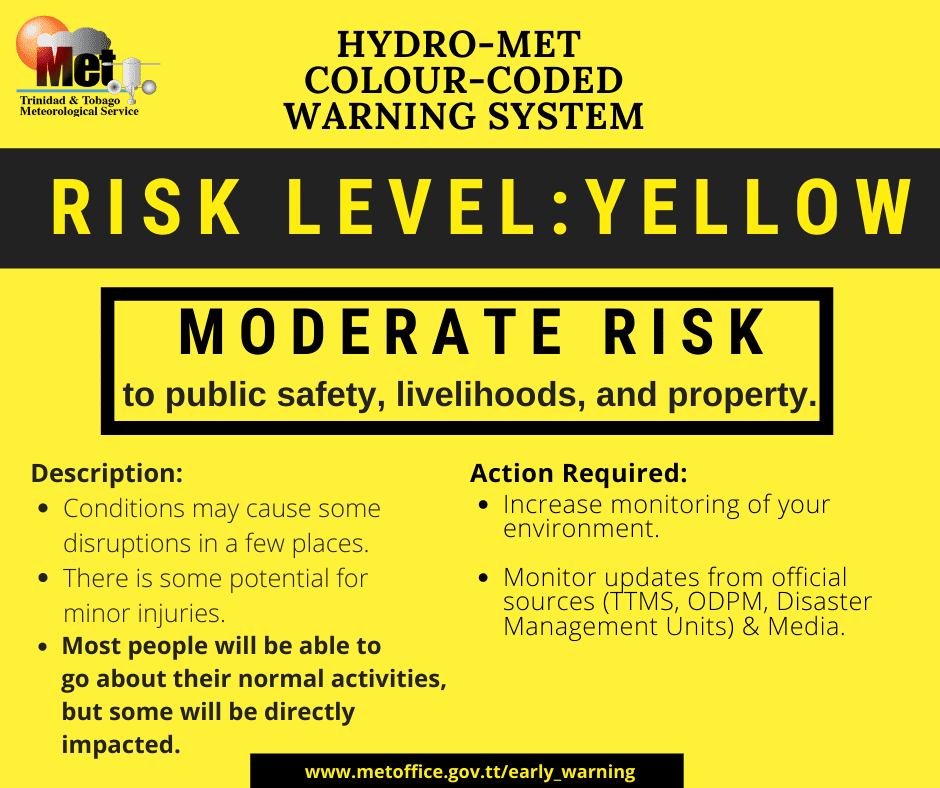Periodic showers, as forecast, have continued to affect Trinidad and to a lesser extent, Tobago over the past 36 hours. However, with increasing convergence and favorable upper-level conditions, additional periods of rain and occasional heavy showers are forecast for the country.
The Trinidad and Tobago Meteorological Service has now expanded the Adverse Weather Alert to include Tobago, and maintains it for Trinidad, as of 2:59 PM Thursday. Shortly before this new alert went into effect for Tobago, heavy showers moved across the island, producing wind gusts at 41 KM/H at Crown Point, with visibility dropping as low as 1 kilometer. Power outages were also reported across the island.
With rainfall forecast to continue overnight through Friday, soils are forecast to become increasingly saturated, leading to an elevated risk of flooding, potentially riverine flooding in eastern areas of Trinidad, and landslides.

What you need to know
— Rainfall: Already, between January 1st and 2nd, between 25 and 50 millimeters of rainfall have accumulated across T&T, with totals up to 100 millimeters favoring southern and eastern areas of Trinidad and localized areas of Tobago. In northeastern Trinidad, 48-hour totals have exceeded 100 millimeters. Through Saturday morning, forecast models indicate up to an additional 25 millimeters of rainfall across most of Trinidad and Tobago. Isolated totals up to 50 millimeters, particularly across eastern Trinidad, are possible through Saturday morning.
— Hazards: Over the next 12-24 hours, the main hazards will be landslides in elevated areas of both islands and the possibility of riverine flooding. As of Thursday evening, major rivers were elevated but within their banks. In heavy showers, street/flash flooding and gusty winds exceeding 40 KM/H are possible.
Latest Alerts
Adverse Weather Alert Discontinued. Showers, Thunderstorms Still In The Forecast
Trinidad and Tobago is NOT under any tropical storm or hurricane threat, watch, or warning at this time.
The Adverse Weather Alert
The Trinidad and Tobago Meteorological Service updated the Adverse Weather Alert (Yellow Level) on Thursday, January 2nd, 2025, at 2:59 PM, now in effect for Trinidad and Tobago. The alert retroactively went into effect for Trinidad and remains effective for both islands now through 6:00 PM Friday, January 3rd, 2025.


As mentioned earlier, the inclement weather forecast is due to a very moist and unstable atmosphere across Trinidad and Tobago.
This “alert” status considers the possibility of the event occurring. This adverse weather event has been observed, and the following impacts are very likely, according to the TTMS:
- Periods of rainfall are expected to affect both islands and off-shore areas intermittently over the next 26 hours.
- The risk of thunderstorm activity is generally lower, however the persistent nature of the rainfall can still result in localized flooding and ponding, especially in low – lying areas and along smaller river courses.
- There is a greater risk for landslides or landslips in vulnerable areas. Gusty winds are also likely during heavier downpours.
- Larger water courses remain contained at this time but are gradually on the rise.
- While the weather will remain unsettled overall, settled periods can also be expected.

The alert’s color indicates the severity of the event and the probability of its occurrence. Currently, the alert level is Yellow. This means that the hazards are very likely, and the severity of the impacts is moderate for this particular alert. You should be aware of the hazards in your area, which are associated mainly with street/flash flooding, riverine flooding, gusty winds near and above 40 KM/H, possibly falling trees, and landslides.
A moderate Adverse Weather Alert can result in possible injuries and behavioral changes, which are required to ensure safety. Minor damage to property may also occur, temporarily disrupting income-earning activities and affecting a couple of communities.
The Met Office advises the public to continue to remain vigilant and monitor weather conditions, assess their surroundings before venturing out, avoid driving or wading through flood waters, take necessary precautions to mitigate potential impacts, follow the instructions of government officials, and monitor weather updates.












